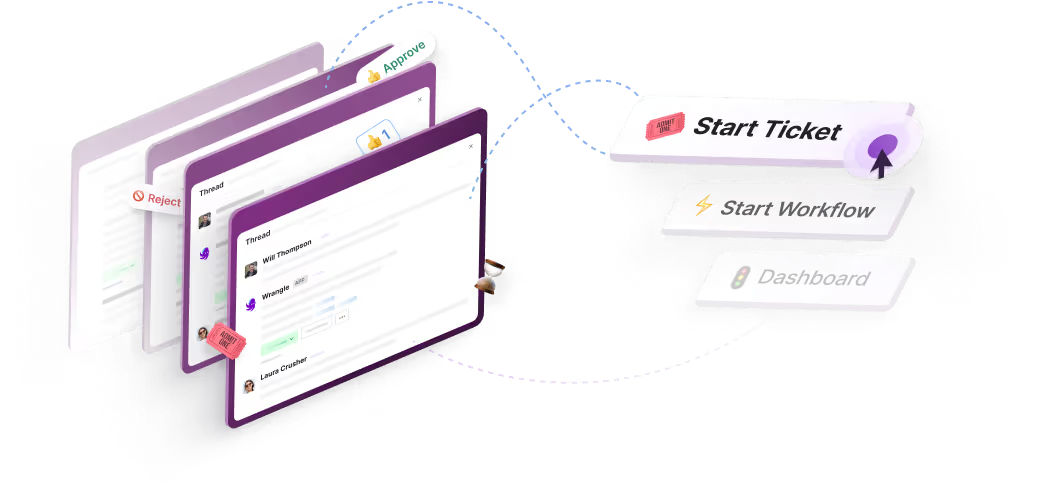A Guide to the Project Approval Process
This post details why a formal approval process is necessary for a successful project and what goes into the project approval process.


Creating the project definition is one of the major steps of project management. The definition includes setting out what will be delivered, who will deliver the project, when it will be delivered, how it will be managed, and last but not least, the budget.
Scope creep will cause the project to run over time and budget unless the project definition is locked down and all stakeholders have signed off on it. Hence, an integral part of the project definition phase is the formal approval of the project definition.
Often, skimping on the formal project approval process leads to later difficulties. This post details why a formal project approval process is necessary for a successful project and what goes into the project approval process. We’ll also illustrate how you can automate this process seamlessly.
"Project approval is a formal business process that every project must go through before you can begin implementing it."
What Is the Project Approval Process?
Project approval is a formal business process that every project must go through before you can begin implementing it.
It's a standardized procedure during which decision-makers ensure that all elements of the project definition meet the organization's quality standards and business requirements. This review covers the subprojects, invoices, budgets, and other processes and deliverables that make up the project.
The approval process is the last stage in project management before the execution of the planned project and consists of the following processes:
- The team plans the final draft of the project deliverables. The project sponsor provides the business objectives. The team provides the approach that will deliver the intended results and ensure that the proposed solution meets corporate standards.
- The team, usually led by the project manager, prepares a formal document. Some organizations have a standard template.
- Management and stakeholders perform a final review of the project output and processes at a formal meeting. In all cases, the stakeholders will include the users of the final deliverables.
- At the review, deliverables are either approved or sent back for refinement and re-approval.
This is an iterative process. It often happens that some elements of the project charter aren't approved. In that case, they're changed, and the project approval process is repeated. In addition, conditional approval, which we'll discuss later, speeds up the development process.
Project Elements
In most cases, the project is extra work for most stakeholders. As a result, the approval process needs to be as frictionless and time efficient as possible. A lot of that comes down to the project plan. The project plan is a formal, approved document, often called a project charter. It's the baseline that's used to manage and control project execution. The project plan is a compilation of deliverables, solutions, and implementation plans created during the planning stage. The level of detail should be appropriate for the project’s scope, complexity, and risk.
There are some steps you can take at the outset to ease the project approval process:
- Identify the lead project sponsor and the project steering committee. The lead sponsor acts as the principal decision-making authority regarding the strategic direction of the entire project. The lead sponsor's support and backing is vital to project success.
- Identify the user stakeholders that prepare the project objectives and definition. Stakeholder representatives sit on the project steering and change control committees.
- Appoint a project manager.
- Identify and assign the roles and responsibilities of the team members. The team includes user representatives.
- Define and document the project organization and reporting structures, including any organizational boundaries and interfaces.
- Determine and source the resources needed for the team, including infrastructure, equipment, and any material needs.
- For large projects and project teams, have a resource plan. It establishes who's needed, when, and for how long. Apart from a core team, the project might need temporary resources to carry out specific, well-defined tasks.
Project Hurdles
Bear in mind that different stakeholders will have different views and requirements. The project charter must reflect everyone’s needs and give all parties a clear understanding of the project and why it should be approved. That can be a difficult task. People management is often the most challenging part of the process.
Steps in the Project Approval Process
Before you create the project charter, there are several actions that you can take to make the approval process much easier further down the line.
Define How the Project Will be Assessed
When a project is initiated, you must define the criteria that will be used during project approval. Approval is carried out by the project steering committee or by a project board that considers all project requests. They will consider:
- the strategic importance of the project to the organization
- any issues around regulatory compliance
- financial viability
- future considerations, such as technical flexibility
- any other issues specific to the organization, such as its regulatory or social environment
Identify Lead and Area Project Sponsors
A lead sponsor is usually a senior executive with the authority to assign resources and provide the executive impulse to the project. Sometimes specific project areas have their own sponsors to bring stakeholders on board.
"Preparing the project charter includes collecting requirements and preparing a detailed project description."
Obtain Interim Approvals
Preparing the project charter includes collecting requirements and preparing a detailed project description. From time to time, the scoping exercise might reach a point where you need more information before a particular aspect of the project can be approved. You might need approval to proceed, especially if there are time or budget implications.
Establish a Positive Feedback Loop
Nothing delays a project and frustrates a team like delays caused by stakeholders. They either provide a deluge of change requests during project approval or ignore the process entirely and complain later that they weren't consulted. Stakeholders must come on board and commit to the project from its earliest stages. With this in mind, a clear and effective feedback process can minimize ownership and communication issues.
In summary, here are the key steps of a positive feedback loop:
- Set up a process for collecting and delivering feedback.
- Nominate one stakeholder from each stakeholder group as a single point of contact.
- Have regular, scheduled feedback meetings with each group.
- Document, document, document.
If this process is successful, there will be less stakeholder pushback at the project approval stage. You can also follow the same process with other team members to ensure potential roadblocks are dealt with as early as possible.
Consider using a development process like design thinking that needs active involvement from the stakeholders.
Project Approval Meeting
The project approval meeting is a formal meeting where all stakeholders are present to discuss the project and, hopefully, formally sign off on the project charter.
If all preparatory steps have been taken, much of the approval work has already occurred. The meeting is likely to follow a formal agenda, which could include the following elements:
- the project description
- the need
- goals and objectives
- stakeholders and benefits
- the suggested solution
- assumptions and constraints
- organizational breakdown structure
- the project scope
- the project lifecycle
- major deliverables
- major milestones
- estimated schedule
- estimated budget
- the return on investment
- the main risks
- the critical success factors
- the communication plan
- the next steps
Each element is self-explanatory and may be broken down into sub-elements depending on the project’s size and complexity.
All attendees receive the relevant documentation before the meeting, and the meeting assumes that they have read and are familiar with it. The meeting chair, the lead sponsor, must ensure that the meeting stays on track.
The outcome can be full project approval, partial approval, or no approval at all.
Automate Project Approvals in Slack
Many of us work on globally distributed teams, making approvals challenging. Your team might not have the luxury of sitting together in a meeting to get approval. Timezone differences prevent work from moving fast, which is why automating your approval chain is important. Many businesses are moving approvals into their Slack workspaces to improve efficiency.
Wrangle is a ticketing and workflow automation platform that can streamline the project approval process for your team. Instead of managing approvals in email threads, Wrangle allows you to create automated workflows or tickets with conditional logic. Here’s how it works.
Build your Wrangle workflow in our no-code workflow builder for your teams. Most workflows can be set up in less than ten minutes. Here’s an example of a blog post approval process. Our workflow has a couple of steps. Your users will input the required information for review in the intake form. From there, this workflow will ping the editor in Slack to review. Once she reviews, the final step will include a task list that tells our team they can publish this post.

Once constructed, your blog approval workflow is accessible in your company’s Slack workspace for your end users to request approvals.

Once a request has been made, Wrangle automatically takes your team through each approval step. We’ll even remind users if they’re taking too long.

When Beverly approves, our workflow has a set of tasks to design the blog header, stage the post, and publish.

When everyone has completed their tasks, the workflow will inform all stakeholders that this project has been approved and completed.

Conclusion
Too many projects fail due to poor planning and inefficient approval processes. A formal project approval process generates a project charter agreed upon and signed off on by all parties, thereby reducing the risk of scope creep in the project.
A Wrangle workflow can automate this process, eliminating complex approval chains. To get started, try the app today and see firsthand how Wrangle can improve communication within your company. We can also provide you with a personalized demo.
This post was written by Iain Robertson. Iain operates as a freelance IT specialist through his own company, after leaving formal employment in 1997. He provides onsite and remote global interim, contract and temporary support as a senior executive in general and ICT management. He usually operates as an ICT project manager or ICT leader in the Tertiary Education sector. He has recently semi-retired as an ICT Director and part-time ICT lecturer in an Ethiopian University.

- Try Wrangle free for 14 days
- Turn messages into trackable tickets
- Build a scalable help desk



Turn Slack into a productivity powerhouse with Wrangle
Create a scalable helpdesk in Slack. Automatically turn messages into trackable tickets and provide faster, more transparent service to your colleagues and customers with Wrangle — Try it free!






